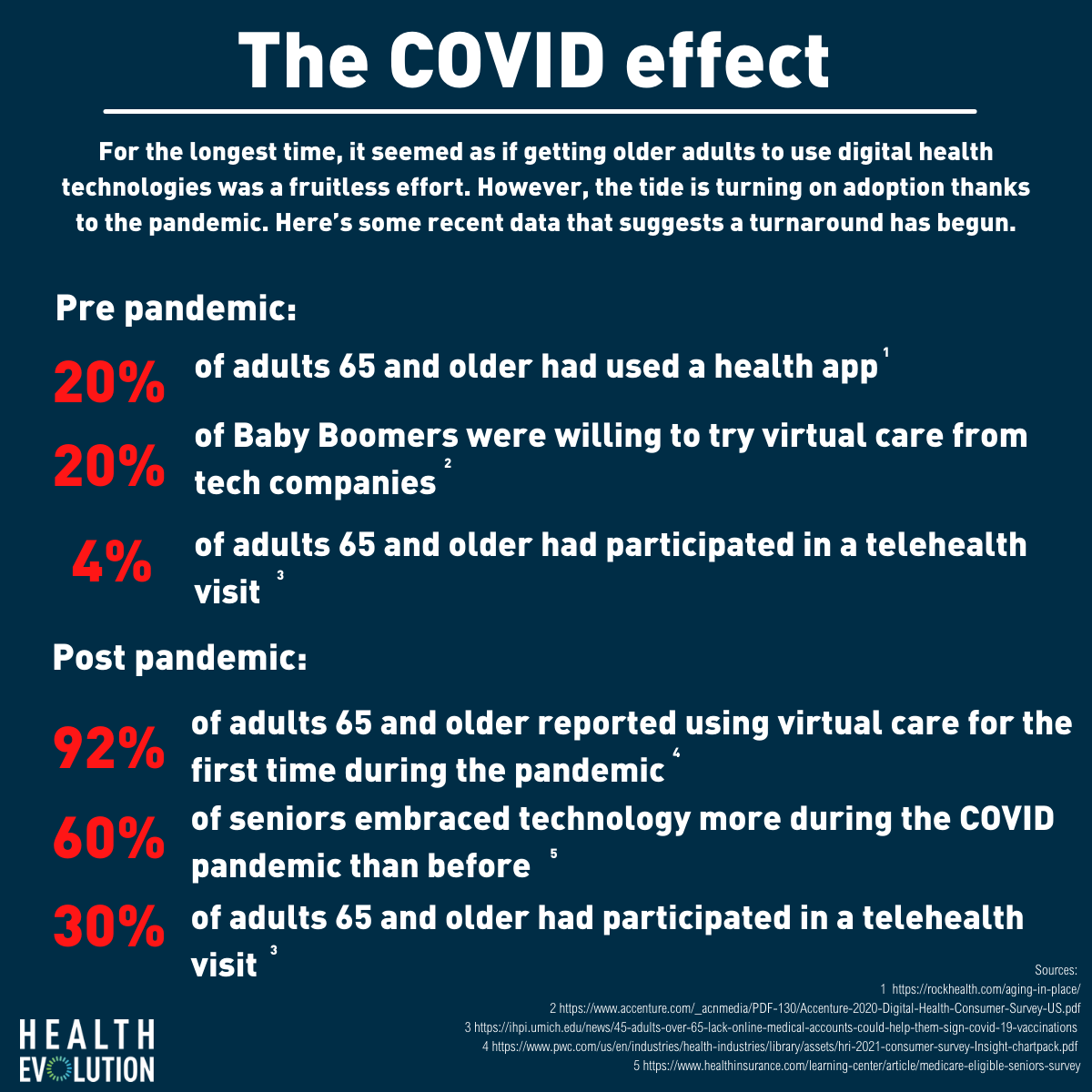When it comes to digital health, conventional wisdom has long suggested that senior citizens aren’t interested in adopting, engaging, or even trying new technologies.
And truthfully, there was a reason for that belief because up until recently, the data has suggested that virtual care is a young person’s game. Accenture’s 2020 Digital Health Consumer Survey, in fact, found that younger generations were more open to receiving virtual care from entities outside their provider relationship. The data suggested that only 20 percent of Baby Boomers were willing to try virtual care from tech companies.
Another survey, from Rock Health in 2019, found that only 20 percent of adults over 65 had used a health care app, compared to nearly 60 percent of people under the age of 55. According to a study in Health Affairs from six renowned geriatric researchers, there are a number of factors that have held back adoption of digital health among older adults. The “lack of access to technology, low digital health literacy, and design barriers in patient portals and apps have disproportionately affected older adults, especially those in underserved communities,” according to researchers.
But the tide is turning thanks in large part to the pandemic.
According to a survey from PwC’s Health Research Institute, consumers 65 and older accounted for the largest share of virtual visit users during the early months of the pandemic. Approximately 92 percent of those aged 65 and older reported using virtual care for the first time. Deloitte Insights found that while Baby Boomers (56-74) and Seniors (75+) had a lower share of virtual health care usage than Gen X, Millennials and Gen Z, they were nearly as comfortable as their younger counterparts in using at-home virtual care platforms to diagnose infections.
A survey from healthinsurance.com found 61 percent of seniors embraced technology more during the COVID pandemic than before and there was a 300 percent increase in seniors using telemedicine. Other research from the National Poll on Healthy Aging found the percentage of older adults who had ever participated in a telehealth visit rose sharply from 4 percent in May 2019 to 30 percent in June 2020. The majority polled found it easy (64 percent very easy, 27 percent somewhat easy) to use the technology necessary to complete their telehealth visit.
Better outcomes for older adults
Wellframe, a digital health company based in Boston, polled its health plan members on engagement and impact from its platform and found that members 60-plus got more out of the digital health experience than any other demographic they surveyed. This included a 40 percent decrease in inpatient utilization among members 60+ and a 29 percent decrease in ER visits. According to Wellframe, its members have four chronic conditions on average, something that has spurring increased digital health usage across all age groups.
“In 2020, we’ve been working with people that have motivation, more than ever, to invest in using digital to help those folks know what to do when they can’t go to their provider as often and to help them follow best practices for prevention. In a way, the COVID pandemic serves as a forcing function for using technology to manage chronic conditions,” Jacob Sattelmair, co-founder, President and CEO of Wellframe, told Health Evolution in an interview from December of last year.
Despite the progress made in the last year, there is a lot of work to be done. The researchers in Health Affairs said there should be continuous efforts to ask “older adults about their access to technology,” as well as “incorporating sociodemographic and literacy metrics, and increasing patients’ and caregivers’ access to EHRs.” A poll of 2,000 adults from the American Association of Retired Persons (AARP) found that people over 65 who envision more widely using telehealth cited a lack of access to both high-speed internet and computers (about one-third of respondents) and a lack of knowledge on how to use telehealth (about one-half) as the biggest barriers to adoption.
“As the coronavirus pandemic continues, telehealth has been a useful tool for older adults to access health care from the safety of their own homes, but we must be mindful that not everyone can access these services,” Alison Bryant, senior vice president of research for AARP, said in a statement.
Infographic data sources:
1 https://rockhealth.com/aging-in-place/
2 https://www.accenture.com/_acnmedia/PDF-130/Accenture-2020-Digital-Health-Consumer-Survey-US.pdf
5 https://www.healthinsurance.com/learning-center/article/medicare-eligible-seniors-survey
Homepage image: canva.com/instaphotos











